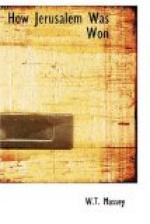By eight o’clock we had taken the whole of the Talat ed Dumm position, and long-range sniping throughout the day did not disturb our secure possession of it. Immediately the heights were occupied the guns went ahead to new points, and armoured cars left the road to try to find a way to the south-east to protect the flank of the right column. They had a troublesome journey. Some of the crews walked well ahead of the cars to reconnoitre the tracks, and it speaks well for the efficiency of the cars as well as for the pluck and cleverness of the drivers that in crossing a mile or two of that terribly broken mountainous country no car was overturned and all got back to the road without mishap.
Throughout the night and during the greater part of the day of February 20 the right column were fighting under many difficulties. In their march from the hill of Muntar they had to travel over ground so cracked and strewn with boulders that in many parts the brigade could only proceed in single file. In some places the track chosen had a huge cleft in the mountain on one side and a cliff face on the other. It was a continual succession of watercourses and mountains, of uphill and downhill travel over the most uneven surface in the blackness of night, and it took nearly eight hours to march three miles. The nature of the country was a very serious obstacle and the column was late in deploying for attack. But bad as was the route the men had followed during the night, it was easy as compared with the position they had set out to carry. This was Jebel Ekteif, the southern end of the range of hills of which Talat ed Dumm was the northern. Ekteif presented to this column a face as precipitous as Gibraltar and perhaps half as high. There was a ledge running round it about three-quarters of the way from the top, and for hours one could see the Turks lying flat on this rude path trying to pick off the intrepid climbers attempting a precarious ascent. Some mountain guns suddenly ranged on the enemy on this ledge, and, picking up the range with remarkable rapidity, forced the Turks into more comfortable positions. The enemy, too, had some well-served guns, and they plastered the spurs leading to the crest from the west, but our infantry’s audacity never faltered, and after we had got into the first lines on the hill our men proceeded methodically to rout out the machine guns from their nooks and crannies. This was a somewhat lengthy process, but small parties working in support of each other gradually crushed opposition, and the huge rocky rampart was ours by three o’clock in the afternoon. Meanwhile two brigades of the Anzac Mounted Division were moving eastwards from Muntar over the hills and wadis down to the Dead Sea, whence turning northwards they marched towards Nebi Musa to try to get on to the Jordan valley flats to threaten the Turks in rear. The terrain was appallingly bad and horses had to be led, the troops frequently proceeding in Indian file. No guns could be got




